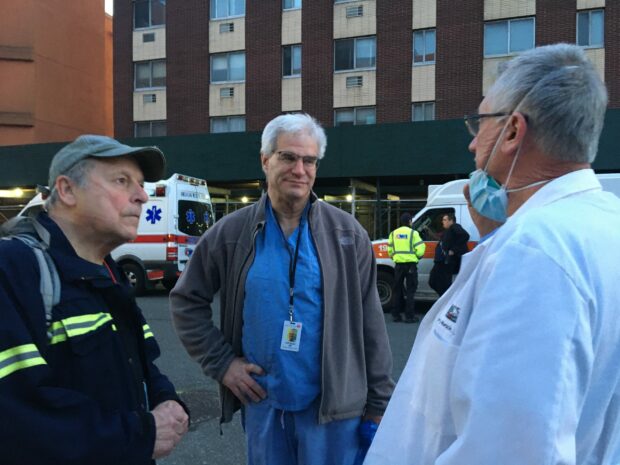HOME | ABOUT US | MEDIA KIT | CONTACT US | INQUIRE
HOME | ABOUT US | MEDIA KIT | CONTACT US | INQUIRE
Olathe-based medical volunteer group wades into the heart of the COVID-19 battle.

Dr. Gary Morsch, right, with physician Jeff Alpert and paramedic Davis Perkins after a Covid Care Force 12-hour day at Jamaica Hospital Medical Center in Queens. N.Y.
Years of mission trips around the world have exposed Dr. Gary Morsch to health-care delivery that would be considered abysmal by American standards.
The standards, though, have been rewritten by the COVID-19 crisis. By the halfway point of a two-week trip with medical volunteers to New York, he had a new understanding of what true medical need looks like.
With the novel coronavirus out of the bag and moving swiftly across the planet, Morsch drew on his history of getting medical professionals into settings where they can do the most good. He’s the founder of the non-profit Heart to Heart International, and of the staffing concern Docs Who Care.
Using his connections to each, he launched Covid Care Force to bring medical professionals on board and provide relief for beleaguered physicians and other providers at hospitals in Queens. “That New York borough,” he says, “is the epicenter of the New York outbreak, which is the epicenter of the U.S. outbreak, which is the epicenter of the global outbreak.”
He took a team one-dozen strong there on March 7 for a two-week run in the trenches. What he saw was—even for him—shocking. The 30-bed emergency room at Jamaica Hospital Medical Center was packed with 100 patients, with others on gurneys double-parked in the hallways. Overworked health-care professionals moved though the humanity to assess dozens of patients.
“It’s very intense,” Morsch said on Day Six for his crew. “You walk into ER and it’s pure chaos. You can’t believe anybody could live this way, work this way. It can be very frustrating, trying to keep track of everyone, but there’s a certain calm in the way the staff goes about it, and they’ve been doing it for a month now.”
Mayor Bill DeBlasio has said that New York needs an additional 100,000 health-care workers to deal with the massive wave of patients who are seriously ill and, in many cases, dying. Five days past the projected peak demand for resources, the region was still short nearly 5,000 ICU beds, and accounted for nearly 11,000 deaths—more than half the nation’s total.
Where, asked Morsch, will 100,000 care providers come from, in a city where the existing medical staff is already exhausted? And with its ranks further depleted by a virus that also infected at least 25 percent of them?
“Even if the epidemic is peaking,” Morsch says, “the back side of that curve means that tens of thousands of New Yorkers are carrying the virus today, unaware of the bomb ticking inside them. There is simply no way,” he said, “that medical professionals there can tolerate additional strain without assistance.”
“The fact is, there are going to be very sick people coming in, even as the number of new cases diminishes or flattens,” Morsch said. “Already, every hospital is basically a complete ICU. They are going to require a lot of nursing care in particular, and it’s going to be the same soon in Louisiana, Michigan and other hot spots.”
“Compounding the challenge,” he said, “is that heart attacks, strokes, acaciadents and drug overdoses haven’t diminished—the routine strains on the system are still there. The stress is just like battle, but here, there’s no treatment like in a combat hospital,” he said.
“His experience there,” he says, “should be cautionary for Kansas City health executives: The health care work force needs to be supported with additional providers,” he says, “because the ones thrown into prolonged service will simply wear out or worse, get sick themselves. And aggressive public-health mitigation policies must be maintained,” he says, “to keep the beast at bay in the Midwest.”
“We have a lot of work ahead of us,” Morsch warns.